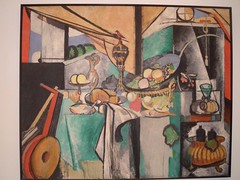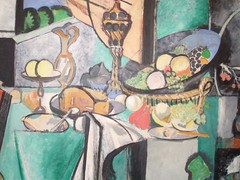
still life after la desserte 1
Originally uploaded by Kit Pollard.
It's been nearly a month since my sister and I visited New York, trolling the MOMA for her thesis and the rest of the city for my stomach. Just after the trip, I promised a few posts addressing the role of food in art - at least in a few specific works of art. In this, I have been remiss, and I am sorry.
As I've mentioned here before, I believe that people who truly love food are predisposed to also truly love other sensory experiences: art, fashion, music. I know that when I look at an amazing work of art, I get the same slight butterflies in my stomach as when I look over an exquisite menu, or hear my new favorite song for the first time.
I supposed I've always assumed, at least subconsciously, that the artists creating fine paintings, beautiful music, or elaborate and delicious meals are connoisseurs of their own, and other, disciplines. Surely, Thomas Keller's amazing creations are borne out of his love for not only food, but art as well.
Right? I mean, I'm no Thomas Keller, but when I stand over my stove, I'm thinking about taste and smell - and aesthetics.
But apparently this is not always the case, at least not for some artists who create their masterpieces outside of the kitchen.
Well before our trip, last August, actually, I read this Peter Schjeldahl New Yorker article about Hilary Spurling's two-volume biography, A Life of Henri Matisse. The article focuses mainly on the second volume of the set, Matisse the Master: Conquest of Colour, which focuses on the second half of the artist's life, from 1909 until his death in 1954.
The article is beautifully written and well worth a read. Schjeldahl weaves Matisse's tempermental, aloof personality with his dysfunctional relationships, explaining how such a complicated and often unhappy character could create works of art so pure and delightful. Schjedahl boldy and, I think, correctly, says of Matisse's body of work,
"Anyone who doesn't love it must have a low opinion of joy."
This dichotomy begins to jar my theory. As a creator of joyous work, like the vibrant still life above (Still Life after La Desserte, 1915), shouldn't Matisse be a connoisseur of all things sensory? Apparently not.
Spurling, the biographer, describes Matisse as something of the opposite of Picasso's hedonist. He wasn't ascetic - he slept with many women, for example - but he didn't seem to enjoy it.
But to a foodie like me, the most jarring sentence of Schjeldahl's article comes towards the end:
"according to Matisse, he never ate even the fresh food that he used for still-lifes including oysters, from a restaurant in Nice, that were returned in time for the lunch crowd."
He painted the food, he celebrated it, he shared it with the world, but he never enjoyed it himself? He didn't eat it, even when it was right there in front of him? And oysters, too!
It was with this quote in mind that I found myself staring at the painting above, and
specifically, at the food depicted in it's center:
still life after la
desserte 2
Originally uploaded by Kit Pollard.
So there I stood, in the middle of the MOMA, after accidentally breaking the rules - twice - by taking flash photos, that I realized...
Sometimes I have no idea what I'm talking about. I can't even remotely presume to know what goes on in the mind of the genius.
But still - and this is the last I'll say on the subject - although Matisse didn't depict his food with the mouth-watering, succulent clarity of, say, the French Laundry Cookbook, his particular style somehow lights the food from within. While when I look at his fruit, I can't taste the juice of orange, I can, somehow, imagine the pleasure that eating that orange would bring. The joy.
And that brings me back to wonder: how is it possible for someone who denied himself simple pleasures like food, who purported not to enjoy those pleasures - how could he so aptly communicate them?

No comments:
Post a Comment